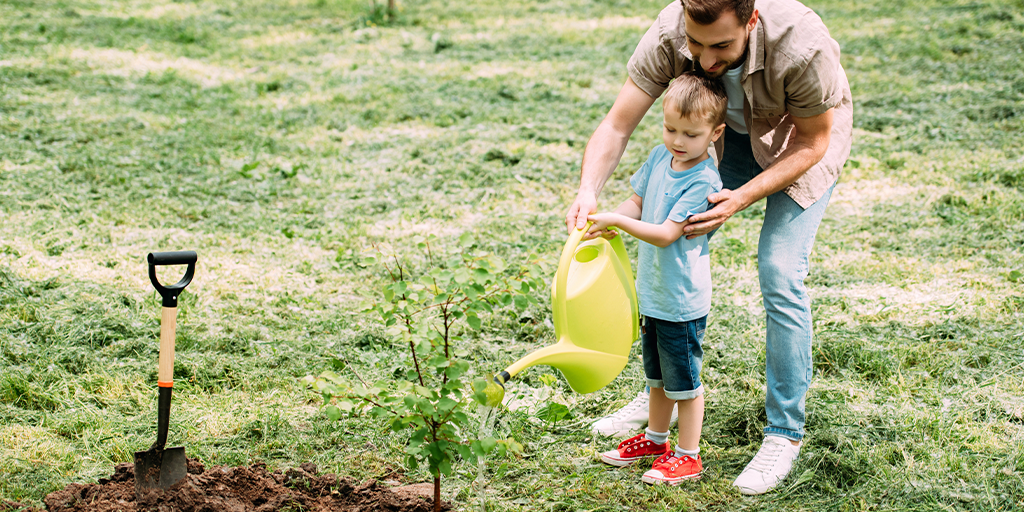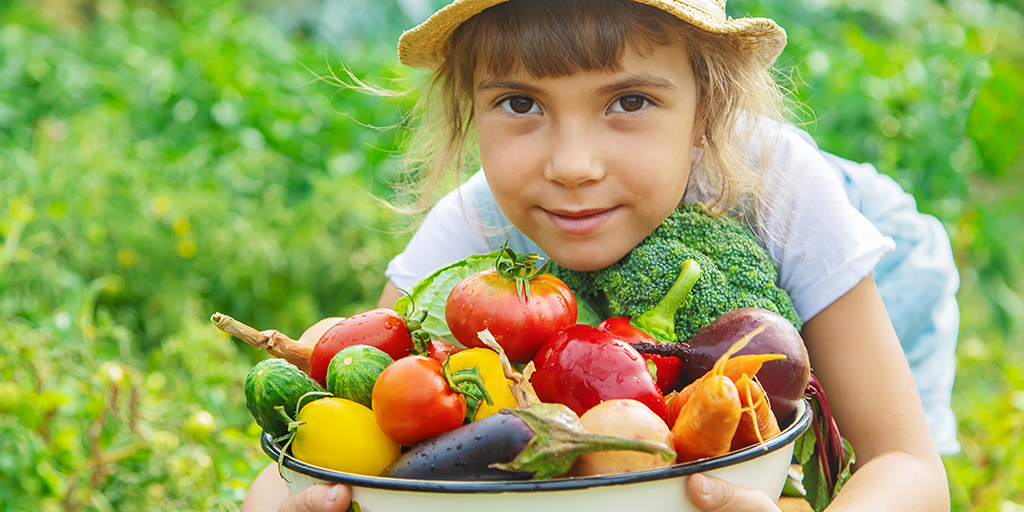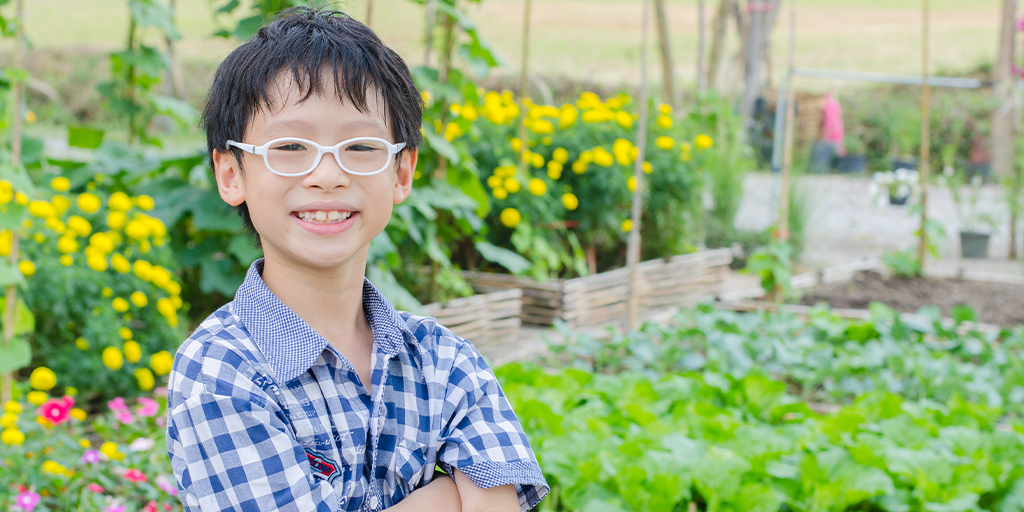Gardening with children does more than just grow beans or make pumpkins for Halloween. It teaches lifelong lessons and a deep love for nature. As children dig into the soil, they do more than just make a hole. They learn about responsibility, sustainability, and how nature works. Here’s some great advice about gardening with kids!

Selecting the Right Plants for Gardening with Kids
Gardening can be an enriching experience for children, teaching them about the cycles of nature, responsibility, and the joy of seeing something grow from a tiny seed. To ensure a rewarding gardening adventure with your little ones, it’s crucial to choose plants that not only thrive with minimal fuss but also engage your children’s curiosity and excitement.
Here are 10 kid-friendly plants that promise both educational value and gardening success:
- Sunflowers: Towering sunflowers are not just a joy to behold; they’re also incredibly easy to grow. Their rapid growth and the transformation from a small seed into a giant plant can teach kids about growth and development, offering a tangible measure of time and effort.
- Radishes: With their quick germination period, radishes are perfect for teaching children patience and the rewards of gardening. They can be ready to harvest in as little as four weeks, offering a fast turnaround from planting to tasting.
- Cherry Tomatoes: Cherry tomatoes are a sweet treat that can be eaten right off the vine (unless you have a lot of slugs crawling on your fruits–then wash them off first). Growing them teaches kids about the care plants need — watering, sunlight, and support — and the satisfaction of enjoying the fruits of their labor.
- Strawberries: Another favorite, strawberries, can be grown in the ground or containers, making them versatile for any garden size. They offer lessons in plant care and the cycles of fruiting, with the added bonus of a delicious harvest.
- Carrots: Pulling up carrots at the end of the season is like digging for buried treasure. This activity can teach children about root vegetables and the importance of soil and space in growing healthy plants.
- Potatoes: Similarly, growing potatoes can be an exciting venture for kids. Planting pieces of potato to see them multiply underground teaches about plant reproduction and offers a surprise during harvest time.
- Peas: Easy to grow and sweet to eat, peas are perfect for early spring gardening. They need little space to flourish and can be grown in containers. Peas also introduce children to the concept of vines and the need for support as plants grow.
- Pumpkins: Planning for a Halloween harvest by planting pumpkins in the summer is a fantastic project. It teaches children about long-term rewards and the factors that affect plant growth, such as water, sunlight, and pest management.
- Lettuce: Growing lettuce offers a quick and easy introduction to leafy greens. It can be harvested at various stages, which teaches kids about continuous growth and the concept of “cut and come again” vegetables.
- Beans: Beans are not only easy to grow but also fascinating for children to watch as they climb. Whether you choose bush or pole varieties, beans can teach about the structure of plants and the way they reach for the sun.
When selecting plants to grow with children, it’s essential to consider their growing conditions and what you have space and time for. But, more importantly, choose plants that will spark your children’s interest. Whether it’s the magic of a sunflower towering over their heads or the surprise of pulling a carrot out of the ground, these gardening experiences can provide valuable lessons and a lot of fun.

Lessons from the Garden
The garden is a living classroom where lessons in science (photosynthesis and soil chemistry), math (measuring plant growth), art (painting, photography, crafts), and literature (journaling the garden journey) naturally emerge. But beyond academics, gardening teaches:
- Patience and Persistence: Watching a seed grow into a plant over weeks or months teaches children the value of waiting and nurturing.
- Responsibility: Regular watering, weeding, and caring for their plants teach children about commitment and the rewards of sustained effort.
- Environmental Stewardship: Understanding the source of their food and the importance of pollinators fosters a respect for the environment and the need to protect it.
Making Gardening a Game: Fun and Educational Activities for Kids
Turning gardening into a series of games can make the experience more enjoyable and educational for children. Here are six detailed games that blend fun with learning, ensuring kids remain enthusiastic about their time in the garden.
- Planting Races:
- Objective: To plant seeds as quickly as possible while following proper planting guidelines.
- How to Play: Each child receives a packet of seeds and a marked area in the garden. Set a timer, and at the start signal, they begin planting their seeds, ensuring they are properly spaced and covered according to the instructions on the seed packet. The first one to finish correctly wins. This game teaches children about following directions, the importance of spacing for plant growth, and offers a practical lesson in seed planting.
- Garden Scavenger Hunts:
- Objective: To find and identify various items in the garden.
- How to Play: Create a list of items for children to find in the garden, such as a red leaf, a worm, a ladybug, or a cloverleaf. Equip each child with a list and a small basket or bag. The first to collect all items or the one to find the most items within a set time wins. This activity encourages observation skills and introduces children to biodiversity in the garden.
- Rainbow Gardens:
- Objective: To plant a garden that visually represents all the colors of the rainbow.
- How to Play: Assign each child a color of the rainbow and challenge them to select and plant flowers or vegetables that correspond with their color. Over the season, as their plants grow and bloom, they will create a living rainbow. This game teaches children about planning a garden with diversity and color coordination in mind, as well as patience as they wait for their plants to grow and bloom.
- Water Relay:
- Objective: To water the garden efficiently and responsibly.
- How to Play: Divide children into teams and give each team a watering can. Set up a start and finish line with the plants that need watering located at the end. Teams race to fill their watering can at the start line, then run to water a designated plant before running back. The next team member then takes a turn. The game continues until all plants are watered. This relay teaches the importance of teamwork and the responsibility of caring for plants, emphasizing the need for regular watering.
- Weed Identification and Removal:
- Objective: To learn about different types of weeds and their impact on the garden.
- How to Play: Teach children about various common weeds and how to safely remove them. Create a chart with pictures and names of weeds. You can do this by using Google Lens on the weeds you already have. Children then hunt for these weeds in the garden, and whoever identifies and removes the most types correctly wins. This game educates children on weed control and the importance of maintaining a healthy garden environment.
- Grow the Tallest Sunflower:
- Objective: To grow the tallest sunflower over the gardening season.
- How to Play: Each child plants a sunflower seed in a designated spot. Over the season, they care for their sunflower, monitoring its growth. At the end of the season, measure each sunflower, and the child with the tallest sunflower wins. This long-term game teaches patience, the importance of regular care, and provides a tangible way to measure the fruits of their labor.
By incorporating these games into gardening activities, children not only learn valuable gardening skills but also develop a deeper appreciation for the environment and the food they eat.
Embracing Mistakes
A crucial aspect of gardening with kids is allowing room for errors. A misplaced seed or an overwatered plant are opportunities for learning, not failures. Celebrate these moments as part of the journey, emphasizing the lesson learned over the outcome.

Themed Gardens
Tailor your garden to your child’s interests to increase their investment and enjoyment. Consider:
- Fairy or Dinosaur Gardens: Incorporate whimsical elements or prehistoric-looking plants to spark imagination.
- Pizza or Salad Gardens: Grow ingredients for favorite meals, connecting the garden’s produce directly to the dinner table.
- Pollinator Gardens: Focus on flowers that attract butterflies, bees, and other pollinators, teaching the importance of these creatures to our ecosystem.
Conclusion
Teaching children to water the garden fosters a sense of responsibility and illustrates the vital role of water in plant life. As they harvest vegetables, they see the tangible rewards of their patience and dedication. Identifying various insects and birds can ignite a curiosity about the diverse forms of life sharing their garden space, while creating a compost pile introduces them to the principles of recycling and environmental stewardship. Additionally, involving them in the design of the garden layout not only taps into their creativity but also teaches them valuable planning skills.

